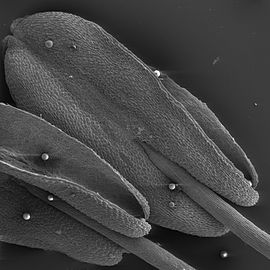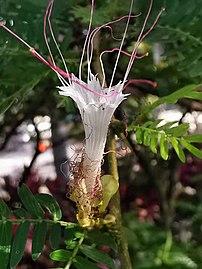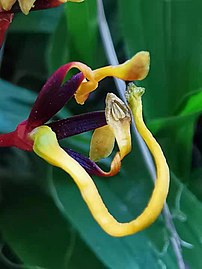Stamen

Thestamen(pl.:staminaorstamens) is a part consisting of the malereproductive organsof a flower. Collectively, the stamens form theandroecium.[1]
Morphology and terminology
[edit]

A stamen typically consists of a stalk called thefilamentand anantherwhich containsmicrosporangia.Most commonly anthers are two-lobed (each lobe is termed alocule) and are attached to the filament either at the base or in the middle area of the anther. The sterile tissue between the lobes is called theconnective,an extension of the filament containing conducting strands. It can be seen as an extension on the dorsal side of the anther. Apollengrain develops from amicrosporein the microsporangium and contains the malegametophyte.The size of anthers differs greatly, from a tiny fraction of a millimeter inWolfiaspp up to five inches (13 centimeters) inCanna iridifloraandStrelitzia nicolai.
The stamens in a flower are collectively called theandroecium.The androecium can consist of as few as one-half stamen (i.e. a singlelocule) as inCannaspecies or as many as 3,482 stamens which have been counted in thesaguaro(Carnegiea gigantea).[2]The androecium in various species of plants forms a great variety of patterns, some of them highly complex.[3][4][5][6]It generally surrounds thegynoeciumand is surrounded by theperianth.A few members of the familyTriuridaceae,particularlyLacandonia schismaticaandLacandonia brasiliana,[7]along with a few species ofTrithuria(familyHydatellaceae) are exceptional in that their gynoecia surround their androecia.
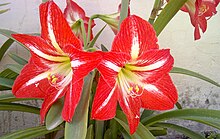

Etymology
[edit]- Stamenis theLatinword meaning "thread" (originally thread of thewarp,in weaving).[8]
- Filamentderives fromclassical Latinfilum,meaning "thread"[8]
- Antherderives from Frenchanthère,[9]from classical Latinanthera,meaning "medicine extracted from the flower"[10][11]in turn fromAncient Greekἀνθηρά(anthērá),[9][11]feminine ofἀνθηρός(anthērós) meaning "flowery",[12]fromἄνθος[9](ánthos) meaning "flower"[12]
- Androecium(pl.:androecia) derives fromAncient Greekἀνήρ(anḗr) meaning "man",[12]andοἶκος(oîkos) meaning "house" or "chamber/room".[12]
Variation in morphology
[edit]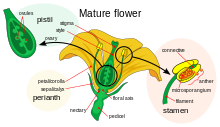
Depending on the species of plant, some or all of the stamens in a flower may be attached to the petals or to thefloral axis.They also may be free-standing or fused to one another in many different ways, including fusion of some but not all stamens. The filaments may be fused and the anthers free, or the filaments free and the anthers fused. Rather than there being two locules, one locule of a stamen may fail to develop, or alternatively the two locules may merge late in development to give a single locule.[13]Extreme cases of stamen fusion occur in some species ofCyclantherain the familyCucurbitaceaeand in sectionCyclantheraof genusPhyllanthus(familyEuphorbiaceae) where the stamens form a ring around the gynoecium, with a single locule.[14]Plants having a single stamen are referred to as "monandrous."

Pollen production
[edit]A typical anther contains four microsporangia. Themicrosporangiaform sacs or pockets (locules) in the anther (anther sacs or pollen sacs). The two separate locules on each side of an anther may fuse into a single locule. Each microsporangium is lined with a nutritive tissue layer called thetapetumand initially contains diploid pollen mother cells. These undergo meiosis to formhaploidspores. The spores may remain attached to each other in a tetrad or separate after meiosis. Each microspore then divides mitotically to form an immaturemicrogametophytecalled apollen grain.
The pollen is eventually released when the anther forms openings (dehisces). These may consist of longitudinal slits, pores, as in theheathfamily (Ericaceae), or by valves, as in thebarberryfamily (Berberidaceae). In some plants, notably members ofOrchidaceaeandAsclepiadoideae,the pollen remains in masses calledpollinia,which are adapted to attach to particular pollinating agents such as birds or insects. More commonly, mature pollen grains separate and are dispensed by wind or water, pollinating insects, birds or other pollination vectors.
Pollen ofangiospermsmust be transported to thestigma,the receptive surface of thecarpel,of a compatible flower, for successfulpollinationto occur. After arriving, the pollen grain (an immature microgametophyte) typically completes its development. It may grow a pollen tube and undergo mitosis to produce two sperm nuclei.
Sexual reproduction in plants
[edit]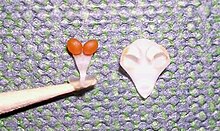
In the typical flower (that is, in the majority of flowering plant species) each flower has bothcarpelsandstamens.In some species, however, the flowers are unisexual with only carpels or stamens. (monoecious= both types of flowers found on the same plant;dioecious= the two types of flower found only on different plants). A flower with only stamens is calledandroecious.A flower with only carpels is calledgynoecious.
Apistilconsists of one or more carpels. A flower with functional stamens but no functional pistil is called astaminate flower,or (inaccurately) a male flower. A flower with a functional pistil but no functional stamens is called apistillate flower,or (inaccurately) a female flower.[15]
An abortive or rudimentary stamen is called astaminodiumorstaminode,such as inScrophularia nodosa.
Thecarpelsand stamens oforchidsare fused into acolumn.[16]The top part of the column is formed by the anther, which is covered by ananther cap.
Terminology
[edit]- Stamen
Stamens can also beadnate(fused or joined from more than one whorl):
They can have different lengths from each other:
- didymous:two equal pairs
- didynamous:occurring in two pairs, a long pair and a shorter pair
- tetradynamous:occurring as a set of six stamens with four long and two shorter ones
or respective to the rest of the flower (perianth):
- exserted:extending beyond the corolla
- included:not extending beyond the corolla
They may be arranged in one of two different patterns:
- spiral;or
- whorled:one or more discrete whorls (series)
They may be arranged, with respect to thepetals:
- diplostemonous:in twowhorls,the outer alternating with the petals, while the inner is opposite the petals.
- haplostemenous:having a single series of stamens, equal in number to the proper number of petals and alternating with them
- obdiplostemonous:in two whorls, with twice the number of stamens as petals, the outer opposite the petals, inner opposite the sepals, e.g.Simaroubaceae(seediagram)
- Connective
Where the connective is very small, or imperceptible, the anther lobes are close together, and the connective is referred to asdiscrete,e.g.Euphorbiapp.,Adhatoda zeylanica.Where the connective separates the anther lobes, it is calleddivaricate,e.g.Tilia,Justicia gendarussa.The connective may also be a long and stalk-like, crosswise on the filament, this is adistractileconnective, e.g.Salvia.The connective may also bear appendages, and is calledappendiculate,e.g.Nerium odorumand some other species ofApocynaceae.InNerium,the appendages are united as a staminal corona.
- Filament
A column formed from the fusion of multiple filaments is known as anandrophore.Stamens can beconnate(fused or joined in the same whorl) as follows:
- extrorse:antherdehiscencedirected away from the centre of the flower. Cf.introrse,directed inwards, andlatrorsetowards the side.[17]
- monadelphous:fused into a single, compound structure
- declinate:curving downwards, then up at the tip (also – declinate-descending)
- diadelphous:joined partially into two androecial structures
- pentadelphous:joined partially into five androecial structures
- synandrous:only the anthers are connate (such as in theAsteraceae). The fused stamens are referred to as asynandrium.
- Anther
Anther shapes are variously described by terms such aslinear,rounded,sagittate,sinuous,orreniform.
The anther can be attached to the filament's connective in two ways:[18]
- basifixed:attached at its base to the filament
- pseudobasifixed:a somewhat misnomer configuration where connective tissue extends in a tube around the filament tip
- dorsifixed:attached at its center to the filament, usuallyversatile(able to move)
Gallery
[edit]-
Scanning electron microscope image ofPentas lanceolataanthers, with pollen grains on surface
-
Lilystamens with prominent red anthers and white filaments
-
Calliandra surinamensispetalized stamens
-
Sterculia foetidastamens
-
Stamen of aGrevillea robusta
-
Commelina communisthree different types of stamens
References
[edit]- ^Beentje, Henk (2010).The Kew Plant Glossary.Richmond, Surrey:Royal Botanic Gardens, Kew.ISBN978-1-84246-422-9.,p. 10
- ^Charles E. Bessey in SCIENCE Vol. 40 (November 6, 1914) p. 680.
- ^Sattler, R. 1973.Organogenesis of Flowers. A Photographic Text-Atlas.University of Toronto Press.ISBN0-8020-1864-5.
- ^Sattler, R. 1988. A dynamic multidimensional approach to floral morphology. In: Leins, P., Tucker, S. C. and Endress, P. (eds)Aspects of Floral Development.J. Cramer, Berlin, pp. 1-6.ISBN3-443-50011-0
- ^Greyson, R. I. 1994.The Development of Flowers.Oxford University Press.ISBN0-19-506688-X.
- ^Leins, P. and Erbar, C. 2010.Flower and Fruit.Schweizerbart Science Publishers, Stuttgart.ISBN978-3-510-65261-7.
- ^Rudell, Paula J.; et al. (February 4, 2016)."Inside-out Flowers of Lacandonia braziliana...etc".PeerJ.4:e1653.doi:10.7717/peerj.1653.PMC4748704.PMID26870611.
- ^abLewis, C.T. & Short, C. (1879).A Latin dictionary founded on Andrews' edition of Freund's Latin dictionary.Oxford: Clarendon Press.
- ^abcKlein, E. (1971).A comprehensive etymological dictionary of the English language. Dealing with the origin of words and their sense development thus illustration the history of civilization and culture.Amsterdam: Elsevier Science B.V.
- ^Siebenhaar, F.J. (1850).Terminologisches Wörterbuch der medicinischen Wissenschaften.(Zweite Auflage). Leipzig: Arnoldische Buchhandlung.
- ^abSaalfeld, G.A.E.A. (1884).Tensaurus Italograecus. Ausführliches historisch-kritisches Wörterbuch der Griechischen Lehn- und Fremdwörter im Lateinischen.Wien: Druck und Verlag von Carl Gerold's Sohn, Buchhändler der Kaiserl. Akademie der Wissenschaften.
- ^abcdLiddell, H.G. & Scott, R. (1940).A Greek-English Lexicon. revised and augmented throughout by Sir Henry Stuart Jones. with the assistance of. Roderick McKenzie.Oxford: Clarendon Press.
- ^Goebel, K.E.v. (1969) [1905].Organography of plants, especially of the Archegoniatae and Spermaphyta.Vol. Part 2 Special organography. New York: Hofner publishing company.pages 553–555
- ^Rendle, A.B. (1925).The Classification of Flowering Plants.Cambridge University Press. p.624.ISBN9780521060578.
cyclanthera.
- ^Encyclopædia Britannica.com
- ^Carr, Gerald (30 October 2005)."Flowering Plant Families".Vascular Plant Family.University of Hawaii Botany Department.Retrieved3 August2022.
- ^William G. D'Arcy, Richard C. Keating (eds.) The Anther: Form, Function, and Phylogeny. Cambridge University Press, 1996ISBN9780521480635
- ^Hickey, M.; King, C. (1997).Common Families of Flowering Plants.Cambridge University Press.ISBN9780521576093.
Bibliography
[edit]- Rendle, Alfred Barton (1911)..InChisholm, Hugh(ed.).Encyclopædia Britannica.Vol. 10 (11th ed.). Cambridge University Press. pp. 553–573.
- Simpson, Michael G. (2011)."Androecium".Plant Systematics.Academic Press. p. 371.ISBN978-0-08-051404-8.Retrieved6 February2014.
- Weberling, Focko (1992)."1.5 The Androecium".Morphology of Flowers and Inflorescences (trans. Richard J. Pankhurst).CUP Archive. p. 93.ISBN0-521-43832-2.Retrieved8 February2014.
- "Obdiplostemony (obdiplostemonous)".Glossary for Vascular Plants.The William & Lynda Steere Herbarium,New York Botanical Garden.Retrieved20 September2019.

